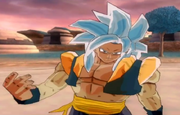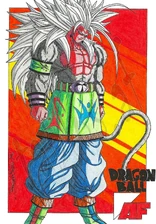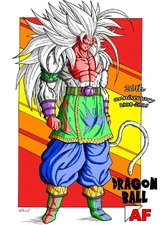|
This article is about the |
Dragon Ball AF (ドラゴンボールAF Doragon Bōru AF) is a long running myth regarding a series in the Dragon Ball franchise after Dragon Ball GT.
Origin
The earliest known record of the image purported to be "Super Saiyan 5 Goku" (drawn by David Montiel Franco, also known as "Tablos.AF") is the May 1999 issue of the Spanish magazine Hobby Consolas.[1][2] By October 2000, a specialized website called Majin.com posted the "Spirit Killer Tablos" drawing as a new SSJ5 Goku, claiming that Dragon Ball AF was a real thing.[3] On November of the same year, the website administrators apologized and said they were tricked by a con artist.[4] After that, and since Majin.com was in English, the misinformation virialized all over the World Wide Web. In the end, a lot of fans—remarkably Toyotarou (then known as Toyble) and Young Jiji—based their own fan art and fan fiction on this fan-made rumor.
Lack of validity
Within the realm of officially licensed properties (which are produced by or with the approval of Bird Studio, Shueisha, and Toei Animation), Dragon Ball AF simply does not exist. Any AF dōjinshi, should they even exist, occupy the same canonical status as fan fiction and fan art. Akira Toriyama publicly stated that he had no intention of continuing the series (which he finished in 1995), though he has drawn a "parody" series, Nekomajin, in which several Dragon Ball characters appear, a one-shot crossover between Dragon Ball and One Piece, in collaboration with One Piece creator Eiichiro Oda, entitled Cross Epoch, and the OVA Dragon Ball: The Return of Son Goku and Friends!. Toriyama also oversaw production of Dragon Ball GT and played a major role in the character designs of Dragon Ball Online.
The Dragon Ball fan site Daizenshuu EX has created a specifically designed list[5] of the features of AF that should disprove its existence to the especially obstinate. These are:

Dragon Ball AF's fake ad
- 1. Lack of advertising in Japanese media.
- This point includes print sources (such as the Japanese Shonen Jump), TV ads, and official Japanese websites. Since Dragon Ball is well-known throughout Japan, a sequel series would not be released unpromoted, nor would it go unnoticed by the Japanese population. Daizenshuu EX took advantage of this fact, however, as part of its 2004 April Fool's joke, creating both a "print ad" and a "TV commercial" from other sources. This material, bereft of its context, has since been cited as "evidence" for the existence of AF.
- 2. Lack of official announcements by Toriyama, Shueisha, or Toei Animation.
- Tying into the idea of "advertising" above, none of the official Japanese sources of Dragon Ball material have come forward with any news on the scale of AF. Such a series would warrant at least a comment, if not an elaborately staged introduction, from one or more of these entities. Of course, this has not stopped fans from claiming that such an announcement has already taken place (though there is no record of one ever occurring).
- 3. Lack of articles, previews, or reviews of the series, in Japanese magazines or online blogs.
- Note, however, that some Japanese fans have taken to commenting on the AF phenomenon outside of Japan, and this may be regarded as commentary on the "series" itself by those who do not speak Japanese. Indeed, the language barrier has often been a source of obfuscation, both for those who would believe the rumors, and those whose goal is to spread them further.
- 4. Lack of scans from manga releases or screen captures/movie clips from new episodes.
- While many "faked" images (generally produced as humorous commentary on the rumors, or outside of AF but incorporated into it accidentally) do exist, there are no raw manga scans or unaltered screenshots available, anywhere. Particularly good artwork may be mistakenly viewed as "promotional art," but no media from within the manga/anime exists. Therefore, the burden of proof is on those who claim they own the series to put forth something they cannot possibly have (calls for such individuals to show whatever material they have are usually met by excuses or ad-hominem attacks).
- Ethical and legal issues aside, a series as popular as Dragon Ball would not long remain without a fan-translated version. The methods of digital distribution are such that it would be virtually impossible not to find such materials, even in a casual search. Neither of these two things exists, however.

Toyotarō announcing he's quitting work on his Dragon Ball AF dōjinshi to work on official Dragon Ball series manga
- 5. Lack of official merchandise.
- Dragon Ball is, and always has been, heavily marketed commercially. In Japan, a multitude of items, from action figures, to snacks, soundtracks, stationery, desks, and even children's eyedrops, have been sold as Dragon Ball products or endorsed by characters from the series. The lack of official AF merchandise, then, is a strong indicator that such a series does not in fact exist.
- 6. Official denial by both Viz Media and Funimation.
- Such denials would run counter to the financial interests of both of these companies (the distributors of Dragon Ball manga and anime in the United States) were the rumors to be true. It is highly unlikely that they would categorically dismiss a property that could make them millions of dollars.
Additionally, the creation of Dragon Ball Super anime as well as the Dragon Ball Super manga by Toyotarou, who notably had previously quit working on his own Dragon Ball AF-inspired dōjinshi to work on official works such Dragon Ball Heroes: Victory Mission and manga adaption of Resurrection ‘F’ further shows that Dragon Ball AF lacks any real validity. It is not uncommon for aspiring mangaka to go from producing doujinshi to doing work on official manga.
Trivia

Super Saiyan 4 Gogeta's alternate color in Budokai Tenkaichi 3
- Though Super Saiyan 5, the Saiyan form shown in Dragon Ball AF, has not been seen in official Dragon Ball material, it is mentioned as a possible form by Bulma in the Dragon Ball GT episode, "The Heart of the Prince". Additionally, in Dragon Ball Xenoverse 2, after Mira absorbs Towa, his transformation resembles that of Super Saiyan 5.
- In the Budokai and Budokai Tenkaichi video game series, the alternate costume for Gogeta in his Super Saiyan 4 form shares the silver hair characteristic with the fan made Super Saiyan 5 form.
- Goku's Perfected Ultra Instinct form from Dragon Ball Super shares the silver hair characteristic with the fan made Super Saiyan 5 form.
- Likely through pure coincidence, there is a mailbox with the letters "AF" on it in West City,[6] as well as on a mailbox in Purple City.[7]
References
- ↑ Hobby Consolas Issue #92, 1999
- ↑ Dragon Ball AF - Nueva ilustración del autor original. hobbyconsolas. Retrieved on May 1999.
- ↑ Original post from 2000 (Mirror on InternetArchives). majin. Retrieved on October 2000.
- ↑ Original editorial post from November 2000 (Mirror on InternetArchives). majin. Retrieved on November 2000.
- ↑ "Dragon Ball AF: Absolutely and patently False", Daizenshuu EX Rumor Guide. kanzenshuu.
- ↑ Dragon Ball episode 43, "A Trip to the City"
- ↑ Dragon Ball Z: The History of Trunks, 1993



